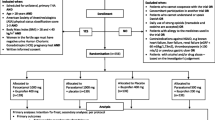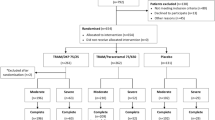Abstract
A multimodal (or balanced) approach to anaesthesia is a familiar concept that offers important benefits in the management of both acute and chronic pain. Rational combinations of analgesic agents with different mechanisms of action can achieve improved efficacy and/or tolerability and safety compared with equianalgesic doses of the individual drugs. Combining different agents also enhances efficacy in complex pain states that involve multiple causes. Combinations of paracetamol plus a weak opioid agent are widely used. One such combination, paracetamol plus tramadol, exploits the well-established complementary pharmacokinetics and mechanisms of action of these two drugs. This combination has demonstrated genuine synergy in animal studies and also combines paracetamol’s rapid onset of efficacy with tramadol’s prolonged analgesic effect. Numerous studies have confirmed the efficacy and tolerability of paracetamol plus tramadol in both acute and chronic pain. As a single-dose treatment for acute post-operative pain, this combination delivers rapid and sustained pain relief that is greater than either agent alone. There is also extensive evidence for efficacy in the long-term management of chronic pain conditions, including osteoarthritis, low back pain and fibromyalgia. In the setting of chronic pain, paracetamol plus tramadol has shown sustained efficacy, safety and tolerability for up to 2 years without the development of tolerance. The efficacy of this combination has been demonstrated as well in respect to reduction of pain intensity and, more importantly, with regard to improvement of function and quality of life and the reduction of disability. Comparative trials have shown that paracetamol plus tramadol has comparable efficacy to paracetamol plus codeine, but with reduced somnolence and constipation compared with the codeine combination. The paracetamol plus tramadol combination is also free of organ toxicity associated with selective and non-selective non-steroidal anti-inflammatory drugs. Hence, paracetamol plus tramadol offers an effective and well-tolerated alternative to anti-inflammatory drugs or other paracetamol plus weak opioid combinations.





Similar content being viewed by others
References
Kaplowitz N (2004) Acetaminophen hepatoxicity: what do we know, what don’t we know, and what do we do next? Hepatology 40:23–26
Hippisley-Cox J, Coupland C (2005) Risk of myocardial infarction in patients taking cyclo-oxygenase-2 inhibitors or conventional non-steroidal anti-inflammatory drugs: population based nested case-control analysis. Br Med J 330:1366
Schug SA, Garrett WR, Gillespie G (2003) Opioid and non-opioid analgesics. Best Pract Res Clin Anaesthesiol 17:91–110
Playford RJ, Vesey DA, Haldane S, Alison MR, Calam J (1991) Dose-dependent effects of fentanyl on indomethacin-induced gastric damage. Digestion 49:198–203
Kehlet H, Dahl JB (1993) The value of “multimodal” or “balanced analgesia” in postoperative pain treatment. Anesth Analg 77:1048–1056
Aitkinhead AR (2001) Textbook of anaesthesia. Churchill Livingstone, London
Crews JC, Hord AH, Denson DD, Schatzman C (1999) A comparison of the analgesic efficacy of 0.25% levobupivacaine combined with 0.005% morphine, 0.25% levobupivacaine alone, or 0.005% morphine alone for the management of postoperative pain in patients undergoing major abdominal surgery. Anesth Analg 89:1504–1509
Kehlet H, Wilmore DW (2002) Multimodal strategies to improve surgical outcome. Am J Surg 183:630–641
Kehlet H, Werner M, Perkins F (1999) Balanced analgesia: what is it and what are its advantages in postoperative pain? Drugs 58:793–797
Scott DA, Blake D, Buckland M et al (1999) A comparison of epidural ropivacaine infusion alone and in combination with 1, 2, and 4 microg/ml fentanyl for seventy-two hours of postoperative analgesia after major abdominal surgery. Anesth Analg 88:857–864
Moizo E, Berti M, Marchetti C et al (2004) Acute pain service and multimodal therapy for postsurgical pain control: evaluation of protocol efficacy. Minerva Anestesiol 70:779–787
Schug SA, Sidebotham DA, McGuinnety M, Thomas J, Fox L (1998) Acetaminophen as an adjunct to morphine by patient-controlled analgesia in the management of acute postoperative pain. Anesth Analg 87:368–372
Hyllested M, Jones S, Pedersen JL, Kehlet H (2002) Comparative effect of paracetamol, NSAIDs or their combination in postoperative pain management: a qualitative review. Br J Anaesth 88:199–214
Montgomery JE, Sutherland CJ, Kestin IG, Sneyd JR (1996) Morphine consumption in patients receiving rectal paracetamol and diclofenac alone and in combination. Br J Anaesth 77:445–447
Macleod AG, Ashford B, Voltz M et al (2002) Paracetamol versus paracetamol-codeine in the treatment of post-operative dental pain: a randomized, double-blind, prospective trial. Aust Dent J 47:147–151
Fricke JR Jr, Karim R, Jordan D, Rosenthal N (2002) A double-blind, single-dose comparison of the analgesic efficacy of tramadol/acetaminophen combination tablets, hydrocodone/acetaminophen combination tablets, and placebo after oral surgery. Clin Ther 24:953–968
Li Wan Po A, Zhang WY (1997) Systematic overview of co-proxamol to assess analgesic effects of addition of dextropropoxyphene to paracetamol. Br Med J 315:1565–1571
Medicines and Healthcare products Regulatory Agency. MHRA withdraws the pain killer co-proxamol. Press release 21 January 2005. Downloaded November 2005. http://www.mhra.gov.uk/home/idcplg?IdcService=SS_GET_PAGE&useSecondary=true&ssDocName=CON002065&ssTargetNodeId=389
Tallarida RJ, Raffa RB (1996) Testing for synergism over a range of fixed ratio drug combinations: replacing the isobologram. Life Sci 58:PL23–PL28
Medve RA, Wang J, Karim R (2001) Tramadol and acetaminophen tablets for dental pain. Anesth Prog 48:79–81
Grond S, Sablotzki A (2004) Clinical pharmacology of tramadol. Clin Pharmacokinet 43:879–923
Ruoff GE, Rosenthal N, Jordan D, Karim R, Kamin M; Protocol CAPSS-112 Study Group (2003) Tramadol/acetaminophen combination tablets for the treatment of chronic lower back pain: a multicenter, randomized, double-blind, placebo-controlled outpatient study. Clin Ther 25:1123–1141
Alwine LK (2000) Long-term (2-year) analgesic efficacy of tramadol/acetaminophen tablets. Ann Rheum Dis 59(Suppl 1):136
Prescott LF (2000) Therapeutic misadventure with paracetamol: fact or fiction? Am J Ther 7:99–114
Edwards JE, McQuay HJ, Moore RA (2002) Combination analgesic efficacy: individual patient data meta-analysis of single-dose oral tramadol plus acetaminophen in acute postoperative pain. J Pain Symptom Manage 23:121–130
Perrot S, Krause D (2002) Comparaison de la tolérance des traitements et de la satisfaction des patients traités par l’association tramadol (37,5 mg)–paracetamol (325 mg) et du tramadol (50 mg) seul pour lombalgies subaiguës. Douleurs 3(Suppl 1):2S55
Silverfield JC, Kamin M, Wu SC, Rosenthal N, CAPSS-105 Study Group (2002) Tramadol/acetaminophen combination tablets for the treatment of osteoarthritis flare pain: a multicenter, outpatient, randomized, double-blind, placebo-controlled, parallel-group, add-on study. Clin Ther 24:282–297
European Medicines Agency Press office (2005) Press release European Medicines Agency concludes action on COX-2 inhibitors. Doc. Ref. EMEA/207766/2005. Downloaded from: http://www.emea.eu.int/pdfs/human/press/pr/20776605en.pdf
US Food and Drugs Administration (FDA) Center for Drug Evaluation and Research (2005) FDA Public Health Advisory. FDA announces important changes and additional warnings for COX-2 selective and non-selective non-steroidal anti-inflammatory drugs (NSAIDs). Downloaded from: http://www.fda.gov/cder/drug/advisory/COX2.htm
Emkey R, Rosenthal N, Wu SC, Jordan D, Kamin M, CAPSS-114 Study Group (2004) Efficacy and safety of tramadol/acetaminophen tablets (Ultracet) as add-on therapy for osteoarthritis pain in subjects receiving a COX-2 nonsteroidal antiinflammatory drug: a multicenter, randomized, double-blind, placebo-controlled trial. J Rheumatol 31:150–156
Peloso PM, Fortin L, Beaulieu A, Kamin M, Rosenthal N, Protocol TRP-CAN-1 Study Group (2004) Analgesic efficacy and safety of tramadol/ acetaminophen combination tablets (Ultracet) in treatment of chronic low back pain: a multicenter, outpatient, randomized, double blind, placebo-controlled trial. J Rheumatol 31:2454–2463
Peloso PM, Rosenthal N, Jordan D, Karim R (2003) Tramadol/acetaminophen combination tablets (Ultracet) for chronic lower back pain: pooled analysis. J Pain 4(2 Suppl 1):26
Rosenthal N, Peloso P, Jordan D, Karim R (2002) A pooled analysis of the efficacy and safety of tramadol/acetaminophen combination tablets (Ultracet) in chronic lower back pain: quality of life measures. Arthritis Rheum 46(9 Suppl):S107
Mullican WS, Lacy JR; TRAMAP-ANAG-006 Study Group (2001) Tramadol/acetaminophen combination tablets and codeine/acetaminophen combination capsules for the management of chronic pain: a comparative trial. Clin Ther 23:1429–1445
Staud R (2002) Evidence of involvement of central neural mechanisms in generating fibromyalgia pain. Curr Rheumatol Rep 4:299–305
Kosek E, Ekholm J, Hansson P (1996) Sensory dysfunction in fibromyalgia patients with implications for pathogenic mechanisms. Pain 68:375–383
Bennett RM (1999) Emerging concepts in the neurobiology of chronic pain: evidence of abnormal sensory processing in fibromyalgia. Mayo Clin Proc 74:385–398
Yunus MB, Masi AT, Aldag JC (1989) Short-term effects of ibuprofen in primary fibromyalgia syndrome: a double blind, placebo-controlled trial. J Rheumatol 16:527–532
Duhmke RM, Cornblath DD, Hollingshead JR (2004) Tramadol for neuropathic pain. Cochrane Database Syst Rev CD003726
Bennett RM, Kamin M, Karim R, Rosenthal N (2003) Tramadol and acetaminophen combination tablets in the treatment of fibromyalgia pain: a double-blind, randomized, placebo-controlled study. Am J Med 114:537–545
Granges G, Zilko P, Littlejohn GO (1994) Fibromyalgia syndrome: Assessment of the severity of the condition 2 years after diagnosis. J Rheumatol 21:523–529
Bennett RM, Schein J, Kosinski MR, Hewitt DJ, Jordan DM, Rosenthal NR (2005) Impact of fibromyalgia pain on health-related quality of life before and after treatment with tramadol/acetaminophen. Arthritis Rheum 53:519–527
Disclosures/financial interests
The author has received research funding and consultant fees from Bristol Myers Squibb, Grünenthal and Pfizer.
Author information
Authors and Affiliations
Corresponding author
Rights and permissions
About this article
Cite this article
Schug, S.A. Combination analgesia in 2005—a rational approach: focus on paracetamol–tramadol. Clin Rheumatol 25 (Suppl 1), 16–21 (2006). https://doi.org/10.1007/s10067-006-0202-9
Received:
Accepted:
Published:
Issue Date:
DOI: https://doi.org/10.1007/s10067-006-0202-9




